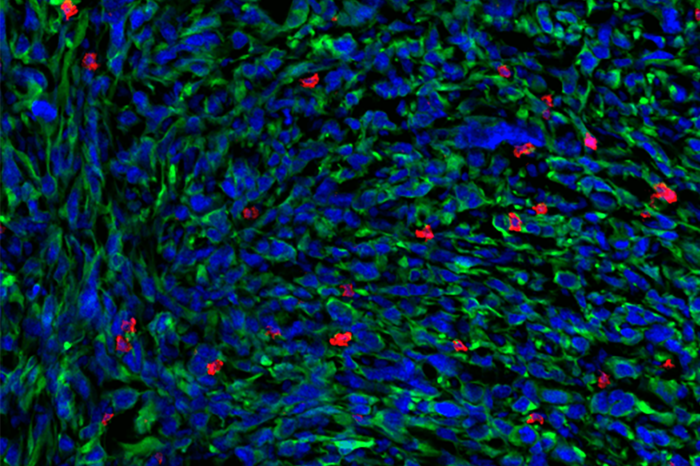Patients with non–small cell lung cancer (NSCLC), the most common lung cancer in humans, are frequently treated with an immunotherapy called immune checkpoint blockade (ICB). This therapy induces a population of tumor-infiltrating T cells called CD8 positive T cells to secrete interferon gamma which in turn induces the expression of programmed cell death ligand 1 (PD-L1).
PD-L1 expression in the tumor microenvironment indicates the T cells are poised to kill tumor cells and patients with PD-L1 positive T-cell infiltrated tumors are most likely to respond to ICB. However, only about 35% of NSCLC patients respond to ICB therapy. Not all CD8 positive T cells in lung tumors express PD-L1 and respond to ICB and little is known about the mechanisms that govern ICB resistance in T cells within NSCLC.
In a new study published in Science Immunology titled, “Lack of CD8+ T cell effector differentiation during priming mediates checkpoint blockade resistance in non–small cell lung cancer,” Stefani Spranger, PhD, professor at the MIT department of biology, and her colleagues uncover what causes some T cells in animal models of NSCLC to fail to respond to ICB, offering a potential way around it.
Jeffrey Bluestone, PhD, professor of metabolism and endocrinology at the University of California, San Francisco, who was not involved with the paper said, “The study provides a potential opportunity to ‘rescue’ immunity in the NSCLC non-responder patients with appropriate combination therapies.”
It has been generally held that the continuous fight against tumor cells exhausts T cells which causes them to stop working. The rationale behind ICB therapy, therefore, has been to reinvigorate the exhausted T cells that pass into the tumor’s microenvironment.
However, experiments conducted by Brendan Horton, PhD, postdoctoral fellow in Spranger’s lab, showed some ICB-resistant T cells stop working before they even enter the tumor, indicating exhaustion is not the cause behind their dysfunction.
Instead, the authors found that gene expression in these T cells is altered during their activation in lymph nodes which causes them to stop functioning. Once activated, T cells specialize into different subtypes with distinct functions that can be detected by specific genetic signatures.
According to Spranger, the idea that the dysfunctional state leads to ICB resistance arises before T cells enter the tumor is quite novel.
“We show that this state is actually a preset condition, and that the T cells are already nonresponsive to therapy before they enter the tumor,” she said. As a result, she explained, ICB therapies that work by reinvigorating exhausted T cells within the tumor are less likely to be effective. This suggests that combining ICB with other forms of immunotherapy that target T cells differently might be a more effective approach to help the immune system combat this subset of lung cancer.
To determine why some tumors are resistant to ICB, the team studied T cells in mouse models of NSCLC. They sequenced mRNA from responsive and non-responsive T cells and used a technique called Seq-Well, developed in the lab of fellow Koch Institute member, J. Christopher Love, PhD, professor of chemical engineering, and a co-author of the study. The technique allows rapid gene expression profiling of single cells. T cells responsive and nonresponsive to ICB show different gene expression patterns at specialized functional states, the single-cell sequencing analysis showed. For instance, nonresponsive T cells express low levels of some cytokines—proteins that control immunity.
Armed with the differential gene expression pattern, the team sought to convert ICB-resistant T cells into ICB-responsive T cells. The researchers treated lung tumors in mouse models with cytokines IL-2 and IL-12. This led the previously nonresponsive T cells to fight cancer cells in the mouse NSCLC.
“This is potentially something that could be translated into a therapeutic that could increase the therapy response rate in non-small cell lung cancer,” Horton said.
Spranger and Horton suspect cytokine therapy could be used in combination with ICB, although current clinical practices avoid cytokine treatments due to potential adverse side effects, including a condition called “cytokine storm” that can be fatal.
Spranger feels this work will help researchers develop more innovative cancer therapies, refocusing their efforts from reversing T-cell exhaustion to earlier states of T-cell specialization.
“If T cells are rendered dysfunctional early on, ICB is not going to be effective, and we need to think outside the box,” she said. “There’s more evidence, and other labs are now showing this as well, that the functional state of the T cell actually matters quite substantially in cancer therapies.”
To Spranger, this means that cytokine therapy “might be a therapeutic avenue” for NSCLC patients beyond ICB.


